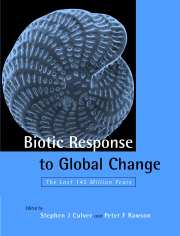Book contents
- Frontmatter
- Contents
- List of contributors
- Preface
- 1 Introduction
- 2 The Cretaceous world
- 3 The Cenozoic world
- 4 Calcareous nannoplankton and global climate change
- 5 Phenotypic response of foraminifera to episodes of global environmental change
- 6 The response of planktonic foraminifera to the Late Pliocene intensification of Northern Hemisphere glaciation
- 7 The response of Cretaceous cephalopods to global change
- 8 Global change and the fossil fish record: the relevance of systematics
- 9 Response of shallow water foraminiferal palaeocommunities to global and regional environmental change
- 10 Intrinsic and extrinsic controls on the diversification of the Bivalvia
- 11 Global events and biotic interaction as controls on the evolution of gastropods
- 12 Algal symbiosis, and the collapse and recovery of reef communities: Lazarus corals across the K–T boundary
- 13 Changes in the diversity, taxic composition and life-history patterns of echinoids over the past 145 million years
- 14 Origin of the modern bryozoan fauna
- 15 Angiosperm diversification and Cretaceous environmental change
- 16 Cenozoic evolution of modern plant communities and vegetation
- 17 Leaf physiognomy and climate change
- 18 Biotic response to Late Quaternary global change – the pollen record: a case study from the Upper Thames Valley, England
- 19 The Cretaceous and Cenozoic record of insects (Hexapoda) with regard to global change
- 20 The palaeoclimatological significance of Late Cenozoic Coleoptera: familiar species in very unfamiliar circumstances
- 21 Amphibians, reptiles and birds: a biogeographical review
- 22 Paleogene mammals: crises and ecological change
- 23 Response of Old World terrestrial vertebrate biotas to Neogene climate change
- 24 Mammalian response to global change in the later Quaternary of the British Isles
- 25 Human evolution: how an African primate became global
- 26 The biotic response to global change: a summary
- References
- Index
23 - Response of Old World terrestrial vertebrate biotas to Neogene climate change
Published online by Cambridge University Press: 14 August 2009
- Frontmatter
- Contents
- List of contributors
- Preface
- 1 Introduction
- 2 The Cretaceous world
- 3 The Cenozoic world
- 4 Calcareous nannoplankton and global climate change
- 5 Phenotypic response of foraminifera to episodes of global environmental change
- 6 The response of planktonic foraminifera to the Late Pliocene intensification of Northern Hemisphere glaciation
- 7 The response of Cretaceous cephalopods to global change
- 8 Global change and the fossil fish record: the relevance of systematics
- 9 Response of shallow water foraminiferal palaeocommunities to global and regional environmental change
- 10 Intrinsic and extrinsic controls on the diversification of the Bivalvia
- 11 Global events and biotic interaction as controls on the evolution of gastropods
- 12 Algal symbiosis, and the collapse and recovery of reef communities: Lazarus corals across the K–T boundary
- 13 Changes in the diversity, taxic composition and life-history patterns of echinoids over the past 145 million years
- 14 Origin of the modern bryozoan fauna
- 15 Angiosperm diversification and Cretaceous environmental change
- 16 Cenozoic evolution of modern plant communities and vegetation
- 17 Leaf physiognomy and climate change
- 18 Biotic response to Late Quaternary global change – the pollen record: a case study from the Upper Thames Valley, England
- 19 The Cretaceous and Cenozoic record of insects (Hexapoda) with regard to global change
- 20 The palaeoclimatological significance of Late Cenozoic Coleoptera: familiar species in very unfamiliar circumstances
- 21 Amphibians, reptiles and birds: a biogeographical review
- 22 Paleogene mammals: crises and ecological change
- 23 Response of Old World terrestrial vertebrate biotas to Neogene climate change
- 24 Mammalian response to global change in the later Quaternary of the British Isles
- 25 Human evolution: how an African primate became global
- 26 The biotic response to global change: a summary
- References
- Index
Summary
INTRODUCTION
… Climate appears to limit the range of many animals, though there is some reason to believe that in many cases it is not the climate itself so much as the change of vegetation consequent on climate which produces the effect…. Where barriers have existed from a remote epoch, they will at first have kept back certain animals from coming in contact with each other; but when the assemblage of organisms on the two sides of the barrier have, after many ages, come to form a balanced organic whole, the destruction of the barrier may lead to a very partial intermingling of the peculiar forms of the two regions …
Wallace (1876)At the time that Wallace published his thoughts on The Geographical Distribution of Animals with a study of the Relations of Living and Extinct Faunas as elucidating the past changes of the Earth's surface, current belief was in the fixed position of the continents. Since the acceptance of plate tectonic theory during the late 1960s large numbers of publications have appeared concerning the biogeography of Old World Tertiary terrestrial vertebrates. These attempt to take account of the effects of past continental movement, the effects on climate of different land/sea configuration, and the effects of changes in ocean currents on marine and terrestrial ecosystems. This chapter considers how the Neogene vertebrates responded to climate change.
- Type
- Chapter
- Information
- Biotic Response to Global ChangeThe Last 145 Million Years, pp. 350 - 366Publisher: Cambridge University PressPrint publication year: 2000
- 6
- Cited by

